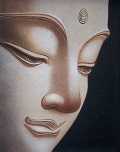Forum Replies Created
-
AuthorPosts
-
Tobias G
ParticipantOk, now I understand where you see the “namarupa” in kusala kamma. Can it be that this preparation of food is just punna kamma and the kusala thoughts with understanding are in the background and operate the kusala mula PS? Otherwise why is it not mentioned in Vb 6 as namarupa? It seems kusala kamma is only mind made.
Tobias G
ParticipantThere is more in the last step of kusala mula PS which adds more argument to my position.
The last step in 2.10.1.1. Mahākusalacitta says: “… bhavapaccayā jāti, jātipaccayā jarāmaraṇaṁ. Evametassa kevalassa dukkhakkhandhassa samudayo hoti”
But we know that jati of a Sotapanna (Anugami) is filled with more dukkha than just “jaramaranam“. Thus this is not the physical birth or the new bhava in the human realm. This can be just the registry in namaloka.
Tobias G
ParticipantThis explanation is better: We do kusala kamma via kusala mula PS and that reduces the ability (the “hook”) to operate the akusala mula PS. When the hook is totally removed every kamma bhava is a dud.
Tobias G
ParticipantYou said: ” … – Viññāṇa dhatu has namagotta PLUS kammic energies, i.e., those energies below the suddhatthaka stage.”
I agree. But those energies are namarupa and that is not mentioned in the kusala mula PS (just “nama”).
Tobias G
ParticipantAgreed, even for the Sotapanna the akusala mula PS will operate at cuti moment.
Do you say that new kamma bhava is accumulated while doing kusala kamma? And this (kusala) kamma bhava is grasped via akusala mula PS at the cuti moment?
We should remind us that kusala kamma is neither dark nor bright with neither-dark-nor-bright results, it is kamma that leads to the destruction of defilements. Thus kusala kamma will not add to kamma bhava. That is the reason it is not mentioned in kusala mula PS.
Tobias G
ParticipantEven for kāmāvacarakusala it is stated as:
Tattha katamo adhimokkhapaccayā bhavo? Ṭhapetvā adhimokkhaṁ, vedanākkhandho saññākkhandho saṅkhārakkhandho viññāṇakkhandho—ayaṁ vuccati “adhimokkhapaccayā bhavo”Same as lokuttara kusala: no kammabhava, just registry in mind.
All punna kamma operate the akusala mula PS and generate rebirth. When removing defilements the kusala mula PS operates (starting from sotapanna anugami?). Can it be that lokuttara kusala means that path factors are fulfilled and magga phala is reached? There it is mentioned:Tattha katamo alobho …pe… adoso …pe… amoho? Yā paññā pajānanā …pe… amoho dhammavicayo sammādiṭṭhi dhammavicayasambojjhaṅgo maggaṅgaṁ maggapariyāpannaṁ
Tobias G
Participant“chaṭṭhā” means sixth, hence the sixth ayatana or manayatana.
Tobias G
ParticipantWhat means Upāsaka?
Tobias G
ParticipantIs fear part of dosa (or any other cetasika)?
(I am not really fearful but jumpy when something happens suddenly. Therefore I ask.)April 12, 2022 at 6:56 am in reply to: “Difference Between Tanhā and Upādāna” in regard to PS cycle #37125Tobias G
ParticipantIn terms of Abhidhamma one does akusala kamma always with those four cetasika:
mōha (ignorance), ahiri (shamelessness), anottapa (fearlessness in wrong), uddhacca (restless mind).So we see, moha is always part of extending the journey in samsara.
April 12, 2022 at 6:15 am in reply to: “Difference Between Tanhā and Upādāna” in regard to PS cycle #37124Tobias G
ParticipantPS starts with the part “pati + icca” (getting attached to an arammana with like or dislike, until namarupa are established with vinnana paccaya namarupa), then it goes on with “sama + uppāda” (creating new bhava/existence, from namarupa paccaya salayatana). The step namarupa paccaya salayatana starts again with a similar object (arammana), hence sama uppada happens if not controlled with panna/sati etc.
Namarupa are in the middle and contain objects of attachment. Whenever we contact similar objects those namarupa show the way how we like to “see” the object. Thus we get attached and add more fuel (san).March 31, 2022 at 8:29 am in reply to: Post on Anidassana, Appaṭigha Rupa Due to Anidassana Viññāṇa #37050Tobias G
ParticipantUnderstood, but I need to ask again:
Katame dhammā anidassanaappaṭighā?
Vedanākkhandho, saññākkhandho, saṅkhārakkhandho, viññāṇakkhandho;
yañca rūpaṁ anidassanaṁ appaṭighaṁ dhammāyatanapariyāpannaṁ; asaṅkhatā ca dhātu
— ime dhammā anidassanaappaṭighā.“Dhammā anidassanaappaṭighā” means
– the mental khandhas
– OR a rupa that belongs to dhammāyatana or to Nibbana?March 31, 2022 at 1:46 am in reply to: Post on Anidassana, Appaṭigha Rupa Due to Anidassana Viññāṇa #37048Tobias G
ParticipantWhat is the translation of this part: “…yañca rūpaṁ anidassanaṁ appaṭighaṁ dhammāyatanapariyāpannaṁ; asaṅkhatā ca dhātu— ime dhammā anidassanaappaṭighā.“
March 30, 2022 at 1:42 pm in reply to: Post on Anidassana, Appaṭigha Rupa Due to Anidassana Viññāṇa #37045Tobias G
ParticipantKatame dhammā anidassanaappaṭighā? Vedanākkhandho, saññākkhandho, saṅkhārakkhandho, viññāṇakkhandho; yañca rūpaṁ anidassanaṁ appaṭighaṁ dhammāyatanapariyāpannaṁ; asaṅkhatā ca dhātu— ime dhammā anidassanaappaṭighā.
There are the khandhas. Those are anidassanaappaṭighā.
March 16, 2022 at 5:22 am in reply to: Early Buddhist Meditation The Four Jhanas as the Actualization of Insight #36968Tobias G
ParticipantI mean upacara/anuloma samadhi is needed, not jhana. But is there any hint in the Tipitaka if more is required to realize Anagami/Arahant? I think such a distinction is not made there.
-
AuthorPosts
